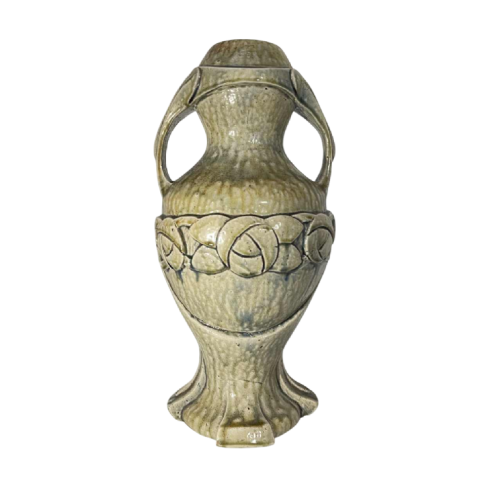Large double-handled amphora vase, Art Nouveau style, attributed to the Helman company, circa 1900.
Made of glazed stoneware, without a base, suggesting outdoor use, allowing water to drain out in case of frost. Stoneware was commonly used at the time for landscaping parks and gardens.
Very good original condition.
Helman company - Célestin Helman (1863–1929):
Célestin Joseph Helman, an architect and surveyor from the Verviers region, began his career working closely with the Hasselt Decorative Ceramics Factory, of which he was a shareholder and member of the management committee. He designed the company's stand for the 1897 International Exhibition in Brussels, which earned him a gold medal.
In 1902, he founded his own company, initially known as “Maison Helman Céramique d'Art”, then “Helman Céramique” and “S.A. Helman Ceramic”. His first workshop was established in Schaerbeek, before moving in 1906 to Berchem-Sainte-Agathe, along the Chaussée de Gand.
Maison Helman became one of the leading names in Art Nouveau ceramics in Brussels, alongside Guillaume Janssens (also in Berchem-Sainte-Agathe) and the Vermeren-Coché factory in Ixelles. These workshops, which were still pre-industrial, worked from models created by artists and painters. Helman tiles were exported as far as the United States.
In addition to Art Nouveau tiles, Helman also produced large decorative scenes, such as the Deep-Sea Fishing Scene at the Poissonnerie du Quartier Léopold (Rue du Trône, Ixelles) and the decorations for the Rôtisserie Vincent (Rue des Dominicains, Brussels). He also created ceramics for Leopold II's Chinese Pavilion.
The company grew to 160 workers and won gold medals at the World's Fairs in Saint Louis (1904) and Liège (1905). It collaborated with renowned designers such as Jacques Madiol (La fée électricité, La mère force motrice) and Joseph Roelants.
After the First World War, the company abandoned Art Nouveau and turned to other styles (Louis XV, flamed stoneware, vases, mantelpieces). When Célestin Helman died in 1929, his widow and two sons took over the company, which now produced modernist façades. It was bought in 1955 by the German group AGROB, closed in 1958 and demolished ten years later.
- Artist / Designer:CÉLESTIN JOSEPH HELMAN (1863 - 1929).
- Period:20th Century / Mid Century / 1900 - 1920.
- Country of Origin:Belgium.
- Dimensions (H x W x D):51cm x 25cm x 26cm.
- Weight:6 Kg.
- Condition:Excellent.
- Style:Art Nouveau.
- Material:Ceramic / Sandstone.
-
Price:850 €
Packaging and delivery costs to be expected:
Collection: Free.
For Belgium: €60.
For France: €100.
For Europe: €120.
For the rest of the world: €300.
